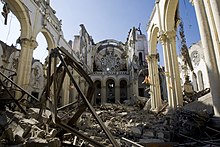Christianity in Haiti
Under French rule, Roman Catholicism was the sole legal religion, though African slaves frequently practiced vodou.
Political control of the island shifted frequently during the 19th century with different European governments, the Dominican republic, Columbia and Haiti itself alternating in power.
The first European to set foot on Haiti, Christopher Columbus landed on December 6, 1492, by way of San Salvador, with three ships.
His own ship, the Santa Maria ran aground near Mole St. Nicolas on the northwest of the island.
Some evangelization efforts were extended to the natives, though this population was soon nearly wiped out through disease and slavery.
Most of the population of Haiti adheres to the Catholic faith, though some combine this with elements of vodou.
Protestantism was introduced to the newly independent nation in 1807, and missionary efforts have been ongoing.
[5] Rara is the yearly festival in Haiti that the peasants and urban poor celebrate.
Processions include walking for miles through local territory, performing new and traditional songs, and attracting fans.
The belief in this celebration is that they are conducting the spiritual work that becomes necessary when the angels and saints along with Jesus, disappear into the Underworld on Good Friday.
[6] Protestantism was the first denomination allowing broadcast programs in 1950, for up to three hours from Monday to Saturday.
The 2015 CIA Factbook reports that around 16% of the population is Protestant (Baptist 10%, Pentecostal 4%, Adventist 1%, other 1%).

